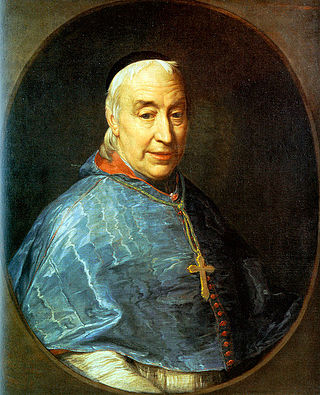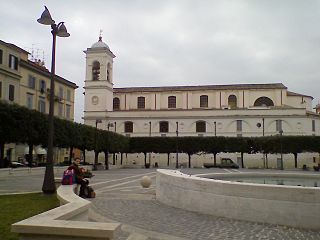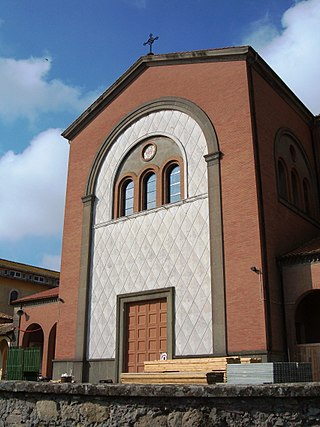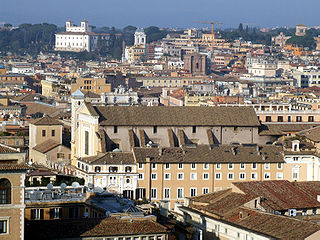In the history of Christianity and later of the Roman Catholic Church, there have been several Councils of Aquileia. The Roman city of Aquileia at the head of the Adriatic is the seat of an ancient episcopal see, seat of the Patriarch of Aquileia.

The Archdiocese of Florence is a Latin Church metropolitan see of the Catholic Church in Italy. It was traditionally founded in the 1st century, according to the 14th century chronicler Giovanni Villani. The diocese was directly subordinate to the Holy See (Papacy) until 1420.

There are more than 930 churches in Rome, which makes it the city with the largest number of churches in the world. Almost all of these are Catholic.

Gian (Giovanni) Domenico Mansi was an Italian prelate, theologian, scholar and historian, known for his massive works on the Church councils.

Santi Nereo ed Achilleo is a fourth-century basilica church in Rome, Italy, located in via delle Terme di Caracalla in the rione Celio facing the main entrance to the Baths of Caracalla. It has been the titular church of Cardinal Celestino Aós Braco since 28 November 2020.

The Four Crowned Martyrs or Four Holy Crowned Ones were nine individuals who are venerated as martyrs and saints of Early Christianity. The nine saints are divided into two groups:
- Severus, Severian(us), Carpophorus (Carpoforus), Victorinus
- Claudius, Castorius, Symphorian (Simpronian), Nicostratus, and Simplicius

The early Christian imperial basilica of the Saints Martyrs Vitale, Valeria, Gervasio and Protasio known more commonly as the basilica of San Vitale and Compagni Martiri in Fovea or more simply as San Vitale al Quirinale. It is the oldest Catholic place of worship in the historic center of Rome, located in via Nazionale. The imperial basilica of San Vitale al Quirinale, built under the pontificate of Pope Siricius after 386 and consecrated and richly decorated by Pope Innocent in 402 is the first public Christian basilica with a baptistery not founded on pre-existing pagan temples, mentioned in the Liber pontificalis, built by the Emperor Theodosius at the behest of Saint Ambrose of Milan, in honor of the miraculous discovery of the bodies of martyrs Gervasius and Protasius in Milan. It is the most frescoed basilica in Rome.

The Archdiocese of Capua is a Latin diocese of the Catholic Church in Capua, in Campania, Italy, but its archbishop no longer holds metropolitan rank and has no ecclesiastical province. Since 1979, it is a suffragan of the Archdiocese of Napoli, i.e. no longer has its own ecclesiastical province nor metropolitan status.

The Diocese of Adria-Rovigo is a Latin diocese of the Catholic Church in the Triveneto. It has existed under this name since 1986. It is a Latin suffragan to the Patriarchate of Venice.

The Diocese of Frosinone-Veroli-Ferentino is a Latin Church ecclesiastical territory or diocese of the Catholic Church in Italy. It has existed since 1986. In that year, the Diocese of Ferentino was united into the Diocese of Veroli-Frosinone, which was the name of the historic Diocese of Veroli from 1956. It is immediately exempt to the Holy See and not part of an ecclesiastical province.

The Diocese of Albano is a Latin suburbicarian see of the Diocese of Rome in Italy, comprising seven towns in the Province of Rome. Albano Laziale is situated on the Appian Way some 15 kilometers from Rome.

The Diocese of Porto–Santa Rufina is a Latin suburbicarian diocese of the Diocese of Rome and a diocese of the Catholic Church in Italy. It was formed from the union of two dioceses. The diocese of Santa Rufina was also formerly known as Silva Candida.

The Basilica of Saints John and Paul on the Caelian Hill is an ancient basilica church in Rome, located on the Caelian Hill. It was originally built in 398.

The Italian Catholic diocese of Todi existed until 1986, when it was united into the diocese of Orvieto-Todi. Up until that point, the diocese had always been directly dependent on the Holy See.

The Diocese of Cesena-Sarsina is a Latin diocese of the Catholic Church in Emilia Romagna was created on September 30, 1986, after the Diocese of Sarsina was united with the historic Diocese of Cesena as a suffragan of the Archdiocese of Ravenna-Cervia.

The Diocese of Anagni-Alatri is a Latin Church ecclesiastical territory or diocese of the Catholic Church in Lazio, Italy. It has existed in its current form since 1986. In that year the Diocese of Alatri was united to the historical Diocese of Anagni. The diocese is immediately exempt to the Holy See.

Michael I Cerularius or Keroularios was the patriarch of Constantinople from 1043 to 1059 AD. His disputes with Pope Leo IX over church practices in the 11th century played a role in the events that led to the Great Schism in 1054.
The Diocese of Tuscanella was a Latin Church residential bishopric of the Catholic Church, in existence by the 7th century. Even at the time of the Lombard invasions, it belonged to the Duchy of Rome and was immediately subject to the Pope. The seat of the bishop was originally in the church of S. Maria, then in the church of S. Pietro, and after 1592 in the church of S. Giacomo.

Santi Dodici Apostoli, commonly known simply as Santi Apostoli, is a 6th-century Roman Catholic parish and titular church and minor basilica in Rome, Italy, dedicated originally to St. James and St. Philip, whose remains are kept here, and later to all Apostles. Today, the basilica is under the care of the Conventual Franciscans, whose headquarters in Rome is in the adjacent building. It is the Station church for Friday, the first week of Lent.
Vitalis of Albano was a Cardinal and bishop of Albano.




















